
The resort town of Svetlogorsk (formerly Raushen) has a rich history and, as a result, a variety of attractions, both preserved architectural monuments of Raushen and objects created during the history of the existence of Svetlogorsk.
The promenade in Svetlogorsk is a long embankment running along the sea line and the entire center of the resort.
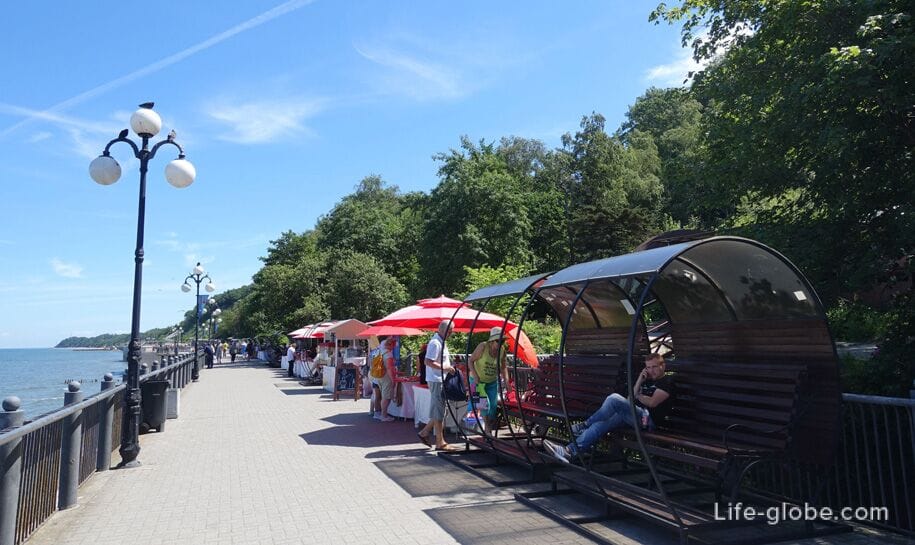

On the promenade are notable:
- a cable car (funicular) connecting the main urban infrastructure located on a hill with the Svetlogorsk promenade. More about the cable car in Svetlogorsk...
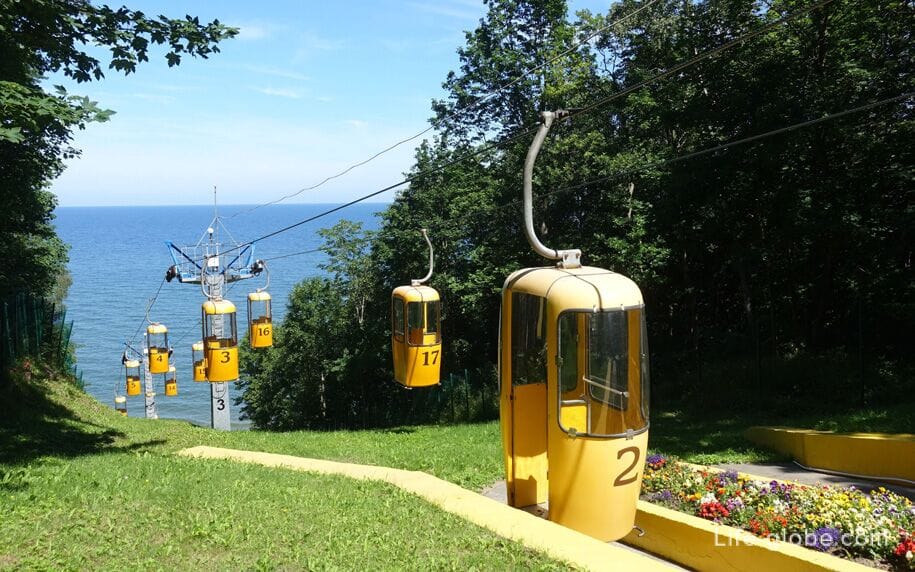
- sculpture "Siren" or "Undine", better known as "Mermaid", located near the 5-star hotel "Grand Palace" and is a bronze graceful sculpture of a girl;
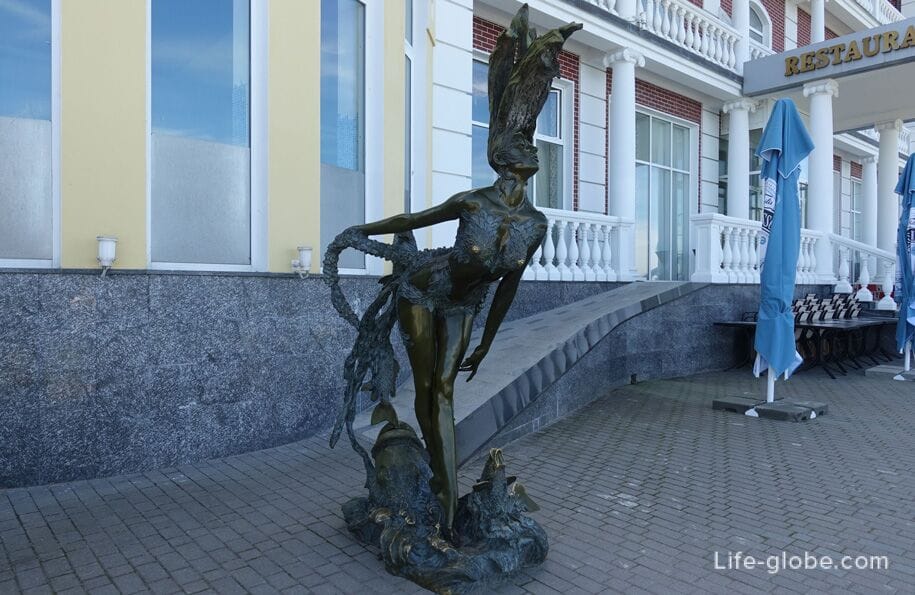
- bronze sculpture "Nymph", located near the serpentine descent to the sea.
The sculpture was created by Hermann Brachert in 1938, cast in bronze in Georgenswald (now the village of Otradnoye) and installed on the promenade in Raushen. The model for the sculpture was seventeen-year-old Kete Tsigan, married Porst.
The mosaic shell surrounding the sculpture was made in the 1980s;
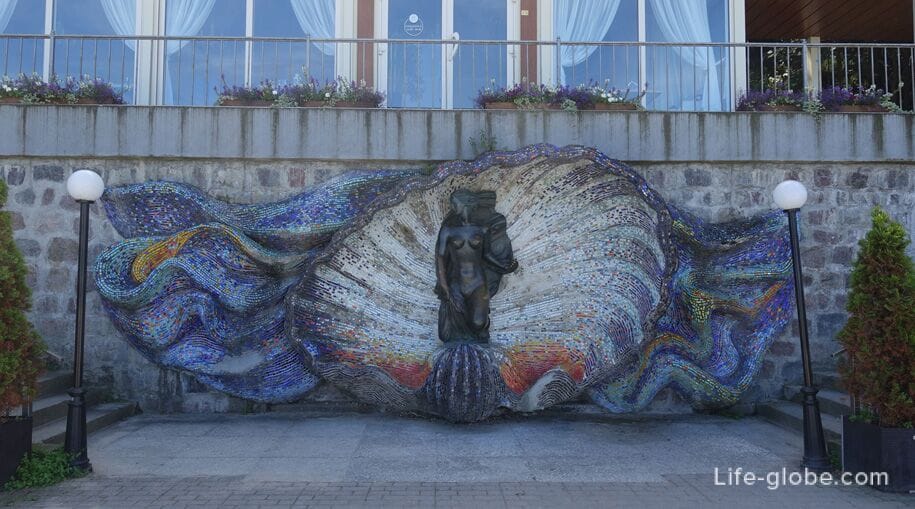
- Zodiac sundial, the work of sculptor Nikolai Pavlovich Frolov, located at the foot of a wide central staircase connecting the promenade with the main urban infrastructure.
The diameter of the clock is 10 meters, and its base is made in the form of a mosaic panel depicting the signs of the zodiac
The clock was installed on the promenade in 1974. For the originality of the composition and the accuracy of the time display, the Svetlogorsk sundial is listed in the Guinness Book of Records as the largest sundial in Europe, made in mosaic technique. Learn more about the beaches and the promenade of the center of Svetlogorsk...
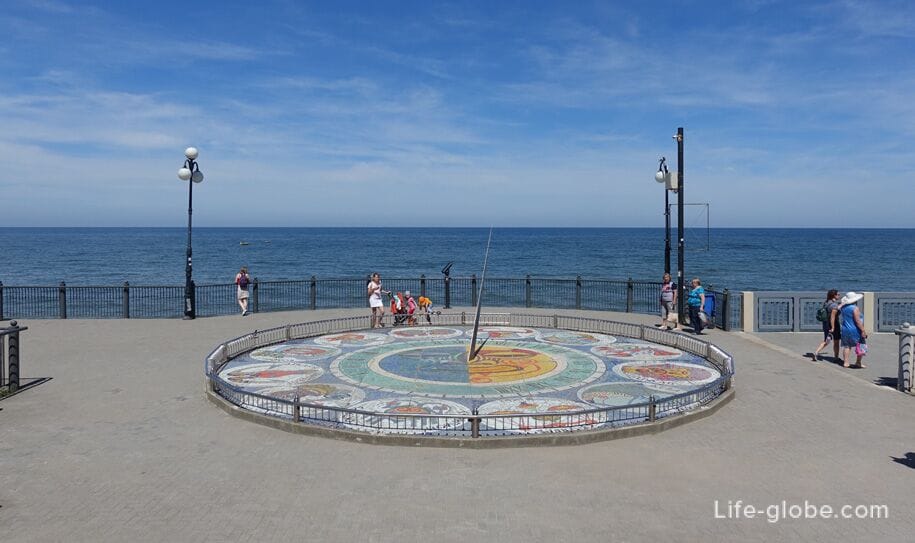
The variety theater "Yantar Hall" is a modern multifunctional concert complex made in a voluminous architectural style (address: Lenin Street, 11).
The Yantar Hall building houses an auditorium, a cinema, a conference hall, a branch of the World Ocean Museum "Marine Exhibition Center", cultural, business, restaurant and entertainment blocks. Read more about the Yantar Hall Variety Theater in Svetlogorsk...

The temple was erected in memory of the tragic death of children and adults as a result of the crash when a military transport plane crashed into a kindergarten on May 16, 1972.
The temple has a small size, clear lines, a low pointed bell tower and is painted white. The temple is located on Lenin Street. More about the temple...

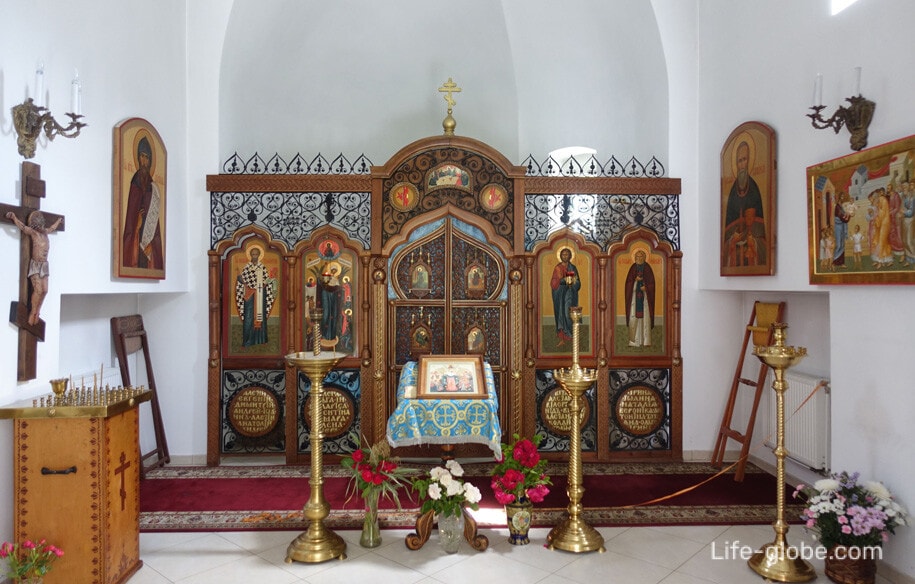
The central square of Svetlogorsk crosses Lenin Street and is one of the most beautiful and favorite places for walking and recreation, both among local residents and guests of the city.
The central square is surrounded by stylized buildings in which shops, souvenir shops and cafes are located.

On the central square are noteworthy: a love bench; a small fountain; an ornamental apple tree with amber apples; a model of Kneiphof Island, now Kant Island, located in the center of Kaliningrad. Learn more about the Central Square of Svetlogorsk...
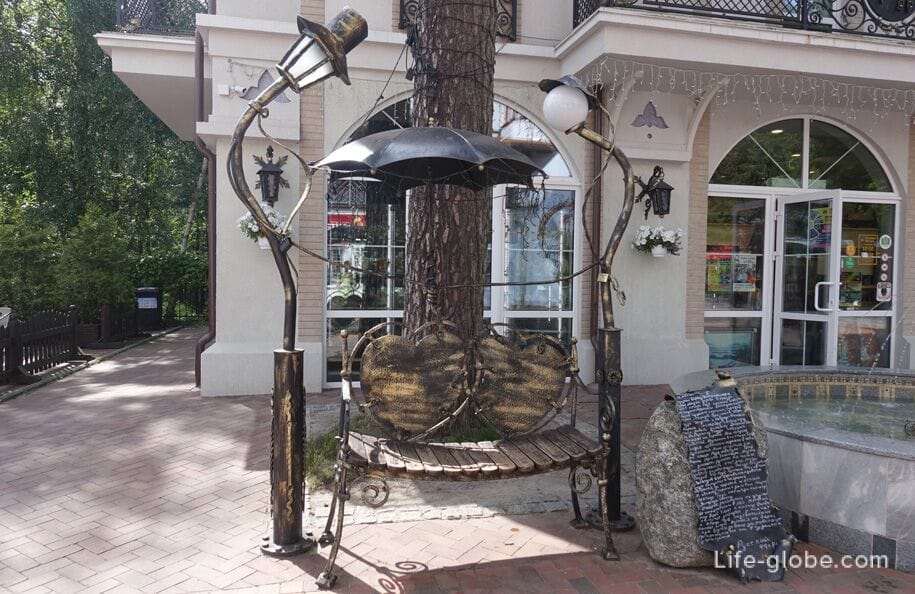
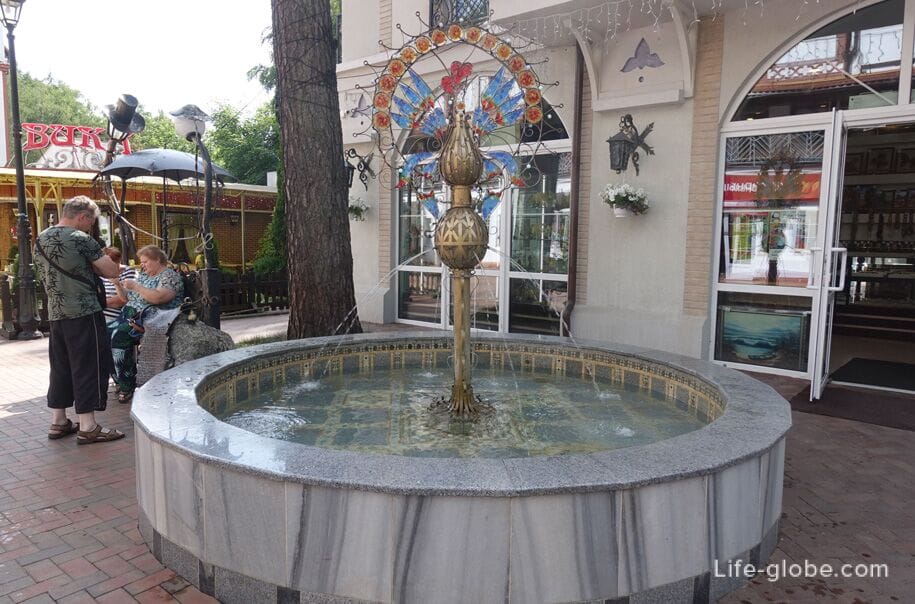
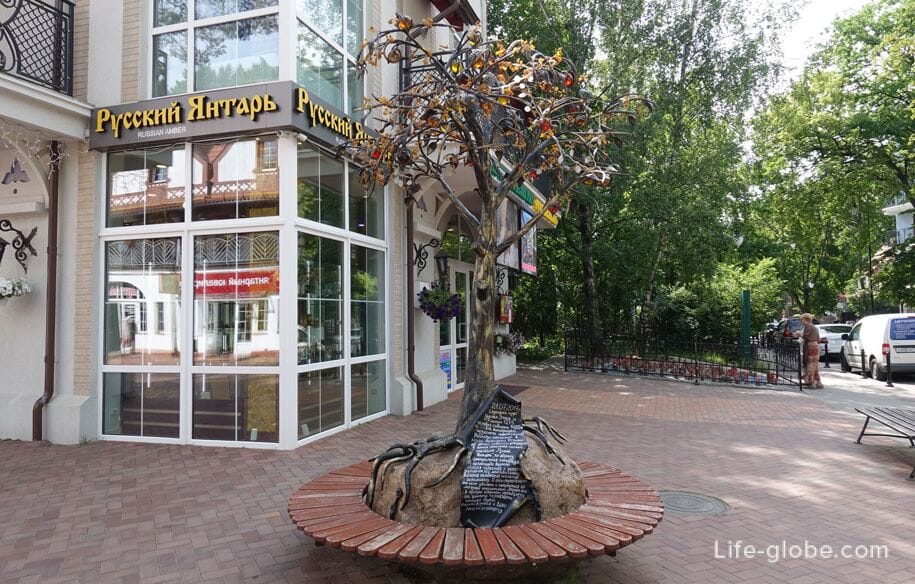
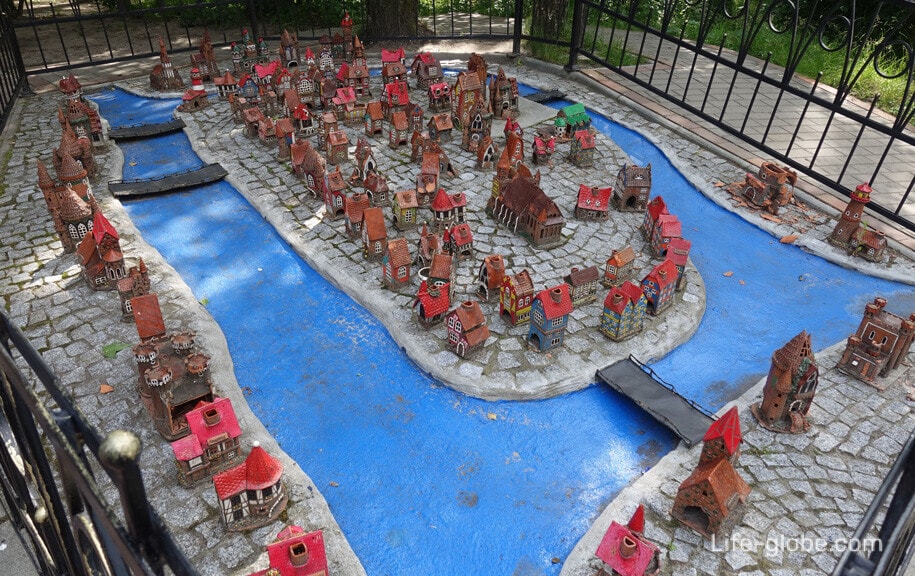
The name "Hunting Lodge" was given to the building due to the fact that there were hunting trophies in its interior.
The hunting lodge is located at 31 Lenin Street and is a house built in 1926 in the Art Nouveau style using decorative elements made of wood.
From 1925 to 1933, the owner of the house was Karl von Streng, the mayor of Rauschen. The house was also used as a boarding house "Sea View", in which, in addition to the living rooms of the burgomaster's family, there were rooms for vacationers for 24 places.
In the post-war years, one of the buildings of the military sanatorium was located in the walls of the building. Since 2003, the building has been privately owned.

The bronze sculpture appeared in the city in 2006 as a symbol of the new Svetlogorsk and its revival.
The sculpture is located on Lenin Street, opposite the Svetlogorsk-2 railway station and represents a female figure sitting on a boulder in a characteristic frog pose, with lips folded for a kiss, with a small crown in the form of a flower bud on her head and with hands and feet resembling frog legs.
They say sculpture fulfills wishes. Read more about the Frog Princess sculpture in Svetlogorsk...

A historical monument located on the territory of the children's health center, on Lenin Street.
The artist Helena Neumann lived in Rauschen, the author of paintings with views of Rauschen and the surrounding landscapes.
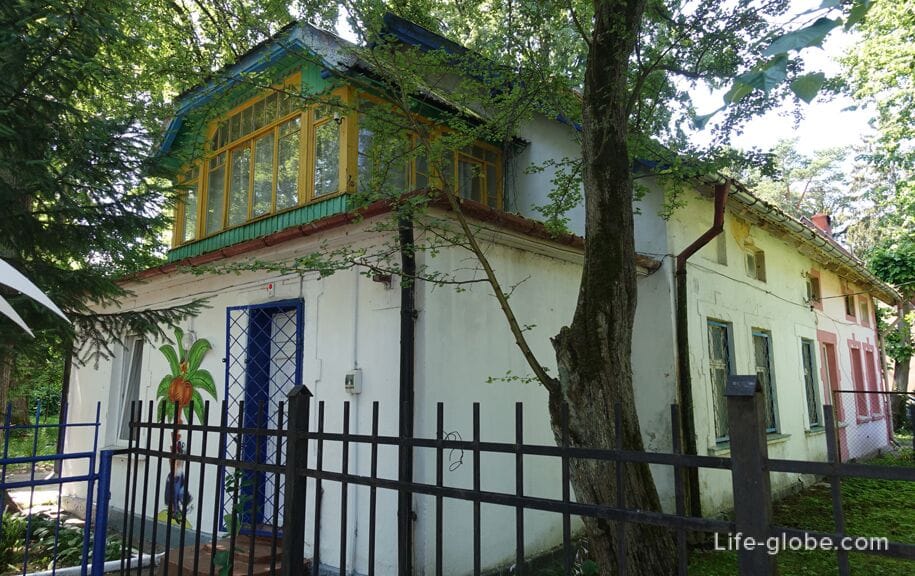
Kurhaus Rauschena (German name Kurhaus) - translated from German means "resort house".
Such a status in the resorts of Germany and East Prussia was awarded to a hotel that was the center of resort life and meets all the high requirements of an institution designed for accommodation and pleasant pastime of resort guests.
The Kurhaus building was erected in 1901 in the Art Nouveau style near the seashore.
The kurhaus consisted of three wooden two-storey buildings with an entertainment part and was an elite hotel with 30 rooms.
Concerts and dance evenings were held in the halls of the kurhaus building, guests played billiards, vacationers were offered drinks and newspapers.
The kurhaus building is located at 36 Oktyabrskaya Street. More about the Kurhaus in Svetlogorsk...
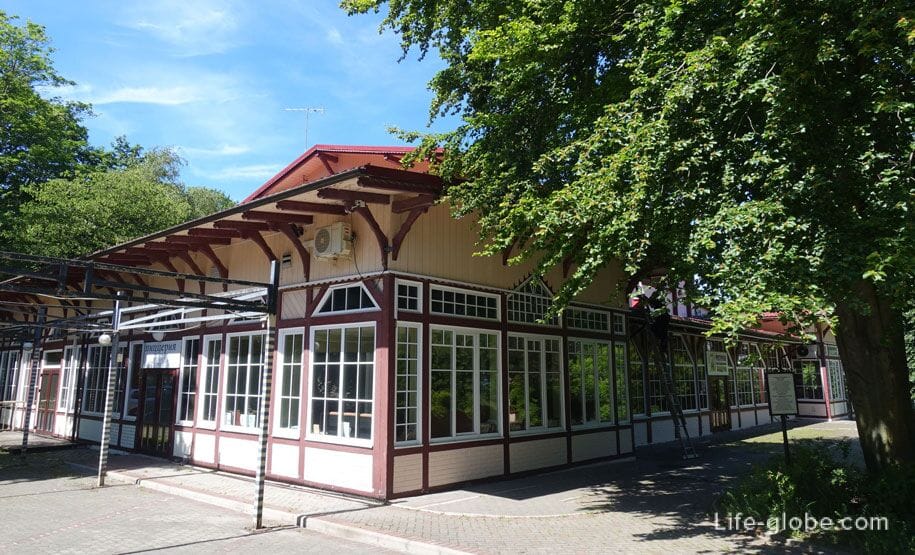
A memorial sign to Thomas Mann was installed on June 6, 2003 in memory of the writer's visit to Raushen in August 1929.
The memorial sign is the work of sculptors Lyudmila Bogatova and Oleg Salnikov and is a granite boulder on which the book is placed in an open form, cast in bronze.
The memorial sign is installed at the end of Oktyabrskaya Street, near the building of the former Kurhaus. Read more about the memorial sign to Thomas Mann in Svetlogorsk...
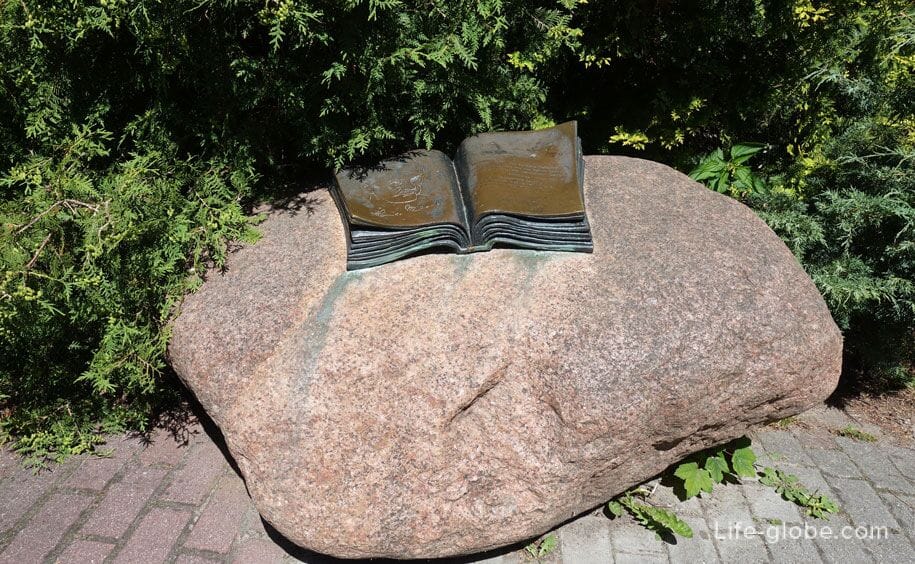
The Rauschen water tower or Rauschen water tower (German name Wasserturm Rauschen) is a historical architectural monument representing the tower and the adjacent building of the hydrotherapy.
The tower of the marine hydrotherapy was built by architect Otto Walter Kukkuk in 1908 in the city of Rauschen in the style of German national Romanticism.
In 1978, the upper part of the tower was decorated with a sundial. The author of the project is Svetlogorsk artist and sculptor Nikolai Frolov.
The tower has a height of 25 meters.
The physiotherapy department of the Svetlogorsk Military Sanatorium branch is now located in the walls of the tower.
Address of the Raushen water tower: Oktyabrskaya Street, 11. Learn more about the Rauschen Water Tower...

At the end of 1928, the pastor of the Catholic community, Shotoff, purchased a plot of land on Warmbaden Strasse in Rauschen for the construction of a Catholic chapel.
The consecration of the choir chapel took place on May 10, 1931. The chapel received a romantic name - "The Virgin Mary - the star of the sea" (German name: Katholische Kapelle Maria - Seestern).
In the post-war years, the chapel building was used as a warehouse, later it was empty and dilapidated.
In 1994, the ruins of the chapel were acquired by the Makarov Company. The head of the company, Andrey Aleksandrovich Makarov, together with a Lithuanian company, brought the historic building back to life.
So a new structure of traditional architecture with half-timbered elements appeared.
A handmade organ, ordered in Germany, was installed in the hall.
Concerts in the organ hall are held all year round, where in addition to organ music, vocal, instrumental and choral music is also played.
The organ hall is located on the territory of the park zone, at the address: 3 Kurortnaya Street. More about the organ hall in Svetlogorsk...
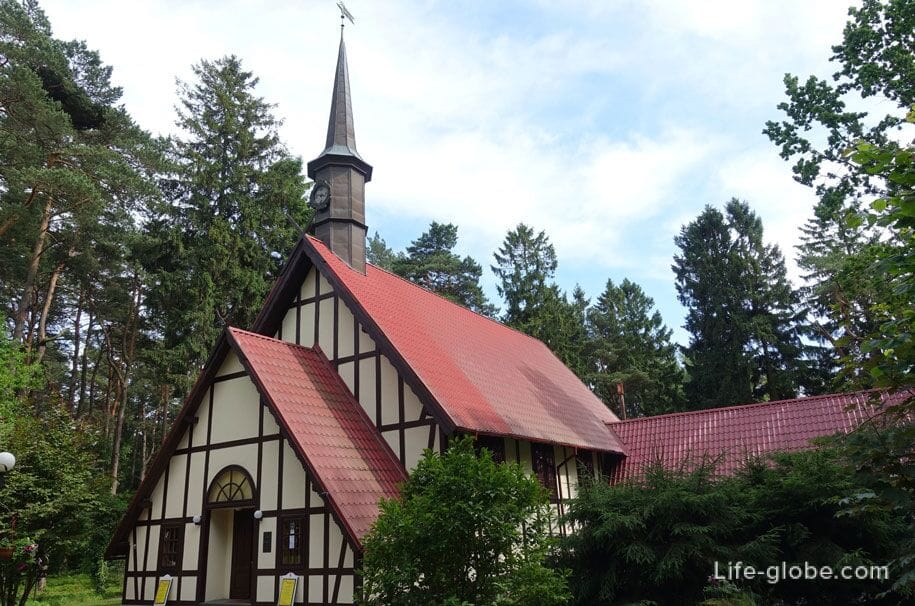
Deciduous Park is a small park that is a popular place for walking and recreation and located in the center of Svetlogorsk, between Oktyabrskaya, Kurortnaya and Sadovaya streets.
The center of the park is decorated with a flowerbed and a sculpture "Carrying Water" (German name Wasserträgerin) by Hermann Brachert.
The sculpture was installed in 1944 in the center of the Raushen Kurpark (currently the Svetlogorsk Larch Park).
From 1945 to 2003, the sculpture was located in the park, after which it was moved to the Herman Brachert House Museum (Otradnoye village), where it is still located. In 2005, a copy of the "Water Carrier" was installed in the Larch Park of Svetlogorsk, in place of the original. More about the Leafy Park in Svetlogorsk...

The hotel "Old Doctor" in the past was a boarding house for the rest of the medical staff of the hospital "Mercy", which was called "Tannenhof" (German name Tannenhoff), which means "Spruce yard", as a dense hedge of low fir trees was planted in front of the building.
The building was built in 1910-1912 and had two floors with an attic.
In the 90s of the 20th century, the building was restored and now it houses the Old Doctor Hotel. More about the Old Doctor Hotel in Svetlogorsk...
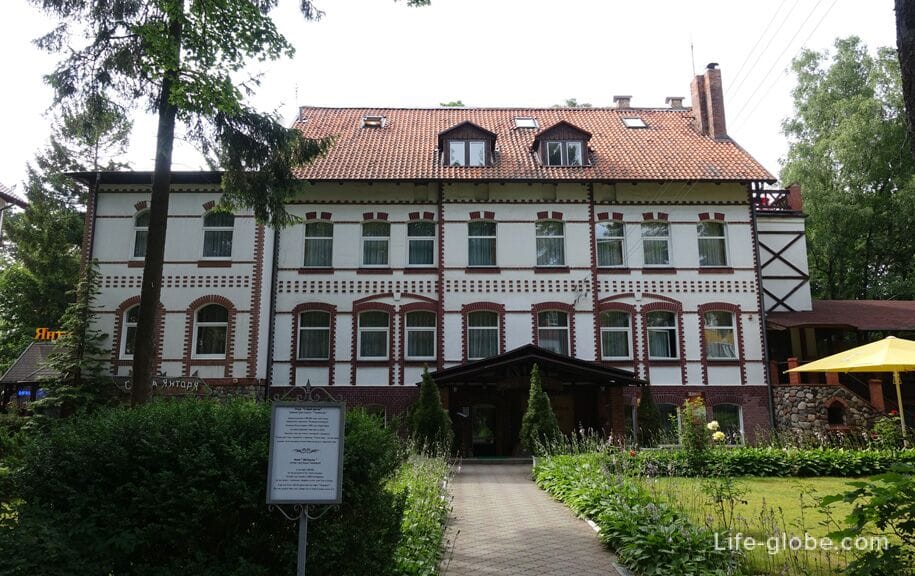
The hotel got its name "Old Doctor", thanks to the monument to Academician I.P. Pavlov, installed near the building.
There is a legend that initially the sculpture depicted the German doctor and microbiologist Robert Koch, the discoverer of the "Koch wand". After the entry of the northern part of East Prussia into the USSR, during the destruction of German monuments, due to the similarity of images, the nameplate on the pedestal was only changed.

The sculptural composition was installed at the beginning of the 20th century on the corner of the house, at the address: Yuri Gagarin Street, 8.
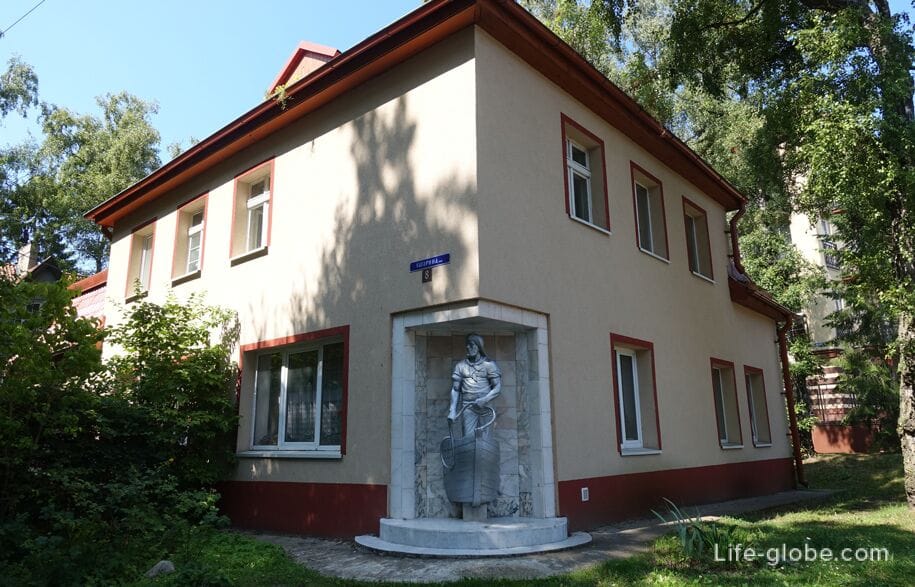
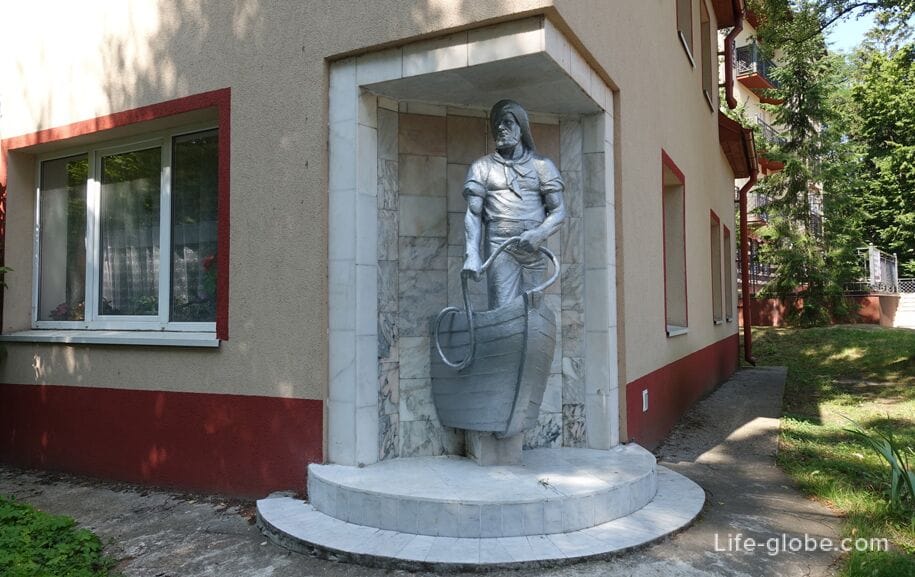
The Church of Seraphim of Sarov is the former Evangelical Lutheran Church of Raushen.
The city Evangelical Church of Raushen was founded in 1903 and was built until 1907. The architects were Wichmann and Kukkuk.
The building was built in the Neo-Gothic style with elements of Art Nouveau.
In the post-war years, the church building was used as a sports hall of a secondary school.
Since 1991, the former church of Raushen has been the Orthodox church of St. Seraphim of Sarov.
The temple is located at 14 Mayakovsky Street.Read more about the Church of Seraphim of Sarov in Svetlogorsk...
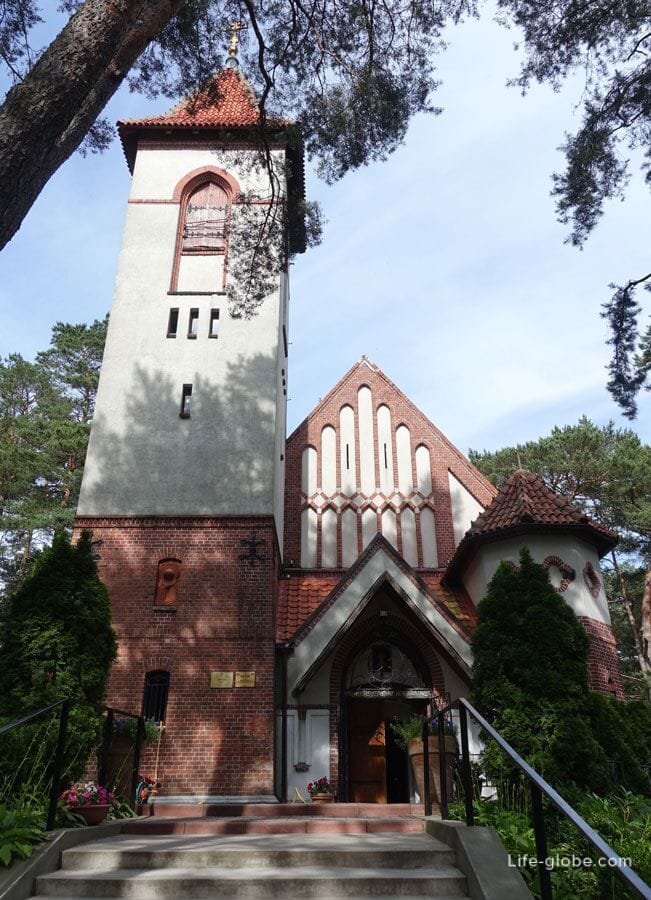

Next to the temple, on the opposite side of Mayakovsky Street, on a small hilly hill isMemorial cross in honor of the residents of the parish who died during the First World War, installed in Rauschen in the 1920s.
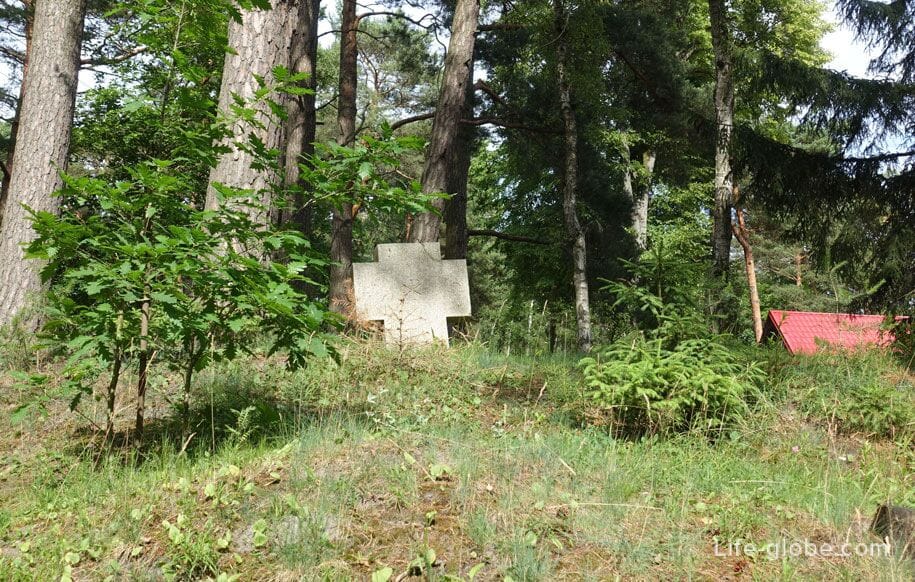
Lake Tikhoe is located between Kaliningrad Avenue (from the sea) and Svetlogorsk Forest.
GPS coordinates: 54.938063, 20.152885.
At the time of Rauschen, the lake was called Mill Pond (Mullenteich). Near the lake in the 19th century, the city began to develop as a resort.
Today, Lake Tikhoe is a popular place for walking and relaxing.
Around the lake there is an embankment with places for recreation and a bike path, a small sports ground with outdoor exercise equipment is equipped, there is a boat station, a rope park "Adventures nearby" and trolls.
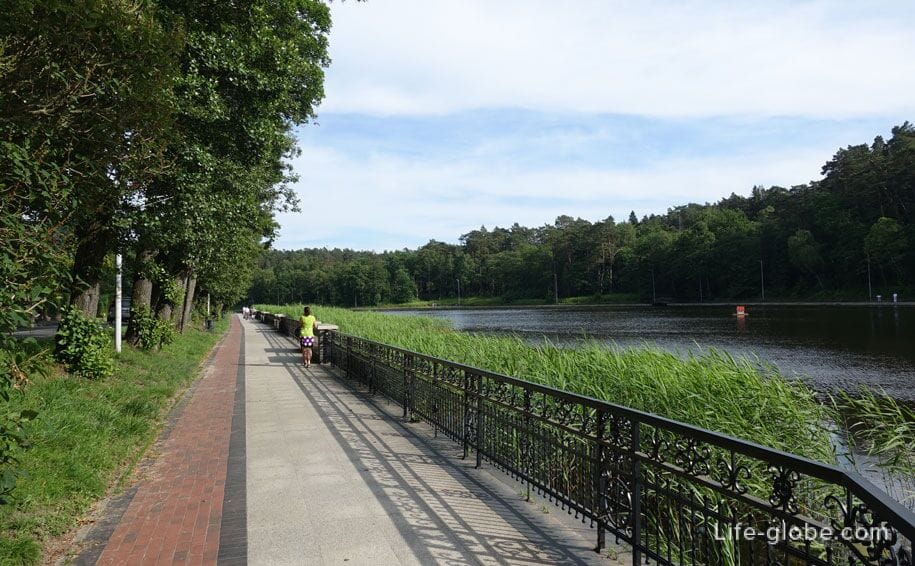
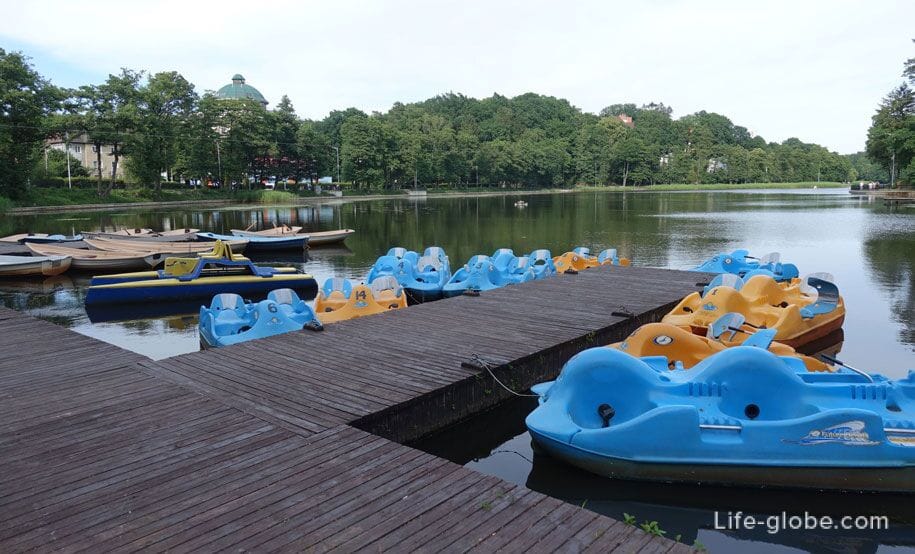
Near the Pacific Lake are:
- a monument of wildlife of All-Russian significance - a linden tree, whose age is more than 450 years.
The 450-year-old linden tree has an 8-meter girth, and information about this long-lived tree is listed in the Guinness Book of Records. Learn more about the 450-year-old lime tree in Svetlogorsk...
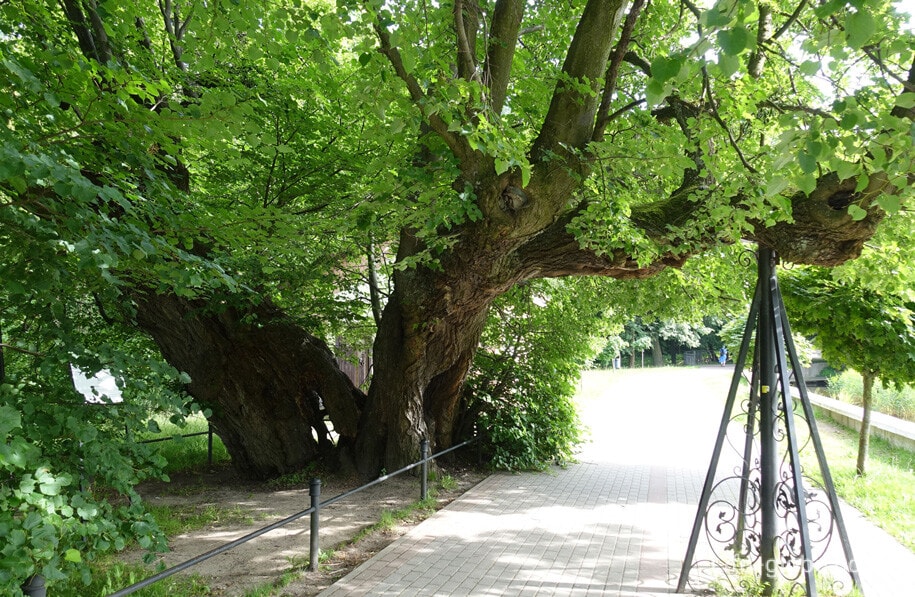
- the sculpture "A girl with a child crossing a stream", installed in Raushen before 1940. Learn more about Lake Tichy in Svetlogorsk...
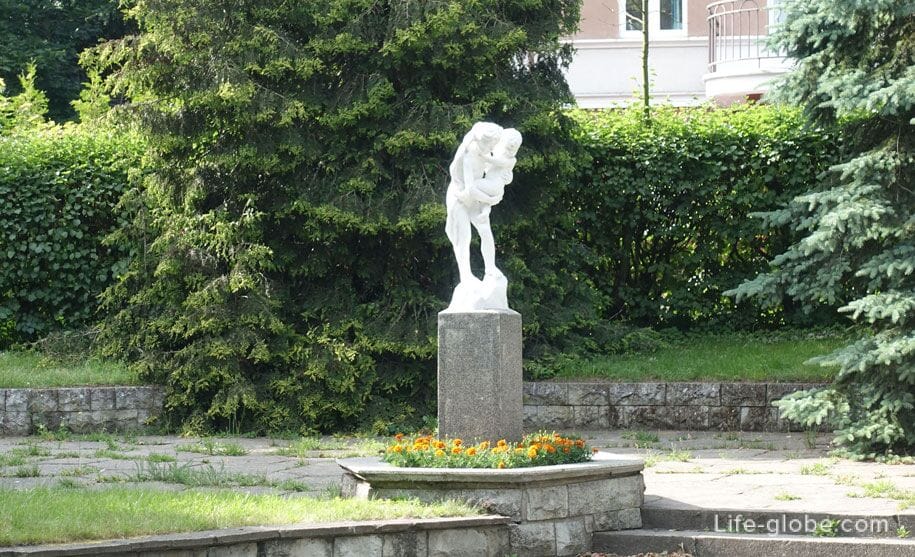
The holiday home "Sonnek" is a historical monument and is located at 6 Karl Marx Street.
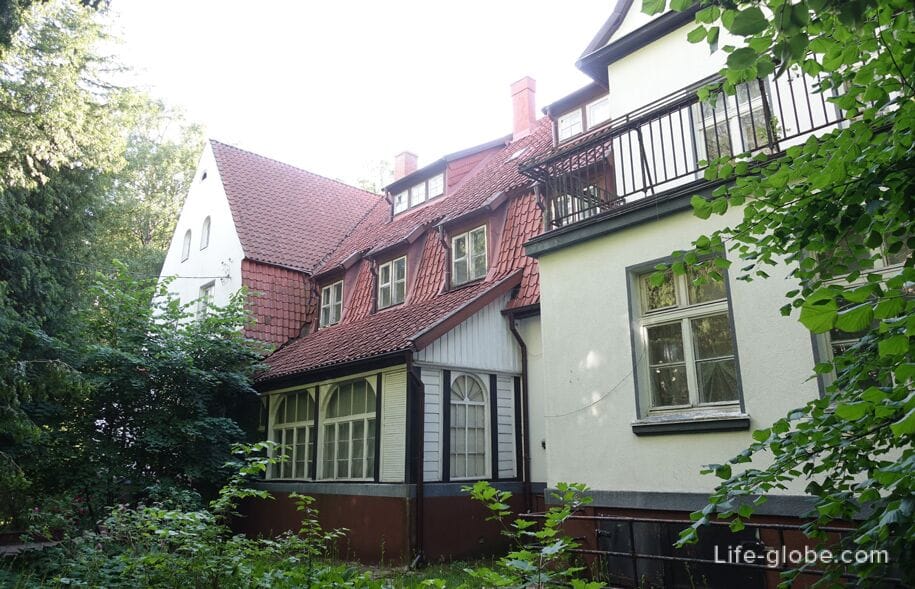
The layout of medieval Konigsberg (now the city of Kaliningrad) is something like a small open-air museum consisting of reduced copies of architectural objects of medieval Konigsberg in the first half of the 16th century.
The basis of the project is the layout of the castle-fortress of Konigsberg, from which only a small part of the ruins (excavations) remain in Kaliningrad, and three medieval cities: Altstadt, Kneiphof and Lebenicht, located near the castle.
The layout is located at Gorky Street / Hoffman Lane, next to the 3-star guest house "Storyteller's House". Learn more about the layout of the medieval Konigsberg...

The composition of the rockery alpine slide is a small open-air museum, where there are a monument and sculptures dedicated to the work of Ernst Theodor Amadeus Hoffmann.
The composition is based on the plots of fairy tales by the German writer, composer, artist and lawyer of the Romantic era, as well as the countryman of all Konigsberzhets (and now Kaliningrad residents) E.T.A. Hoffman.
The composition of the Alpine slide is located at Gorky Street / Hoffmann Lane, next to the layout of the medieval Konigsberg. Learn more about the composition of the Alpine slide...

On the building "Rupp House" there is a memorial plaque to the German sculptor and graphic artist Käthe Kollwitz (1867-1945), installed on July 17, 2003 on the house she visited as a child when she visited her grandfather, the famous theologian Julius Rupp (1809-1884).
House address: 1 Nekrasova Street, next to the 3-star Universal Hotel.
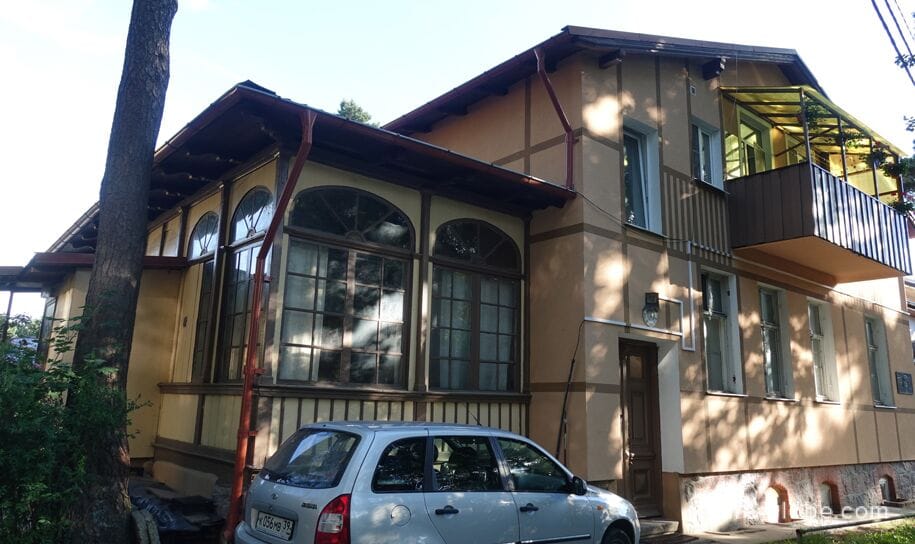
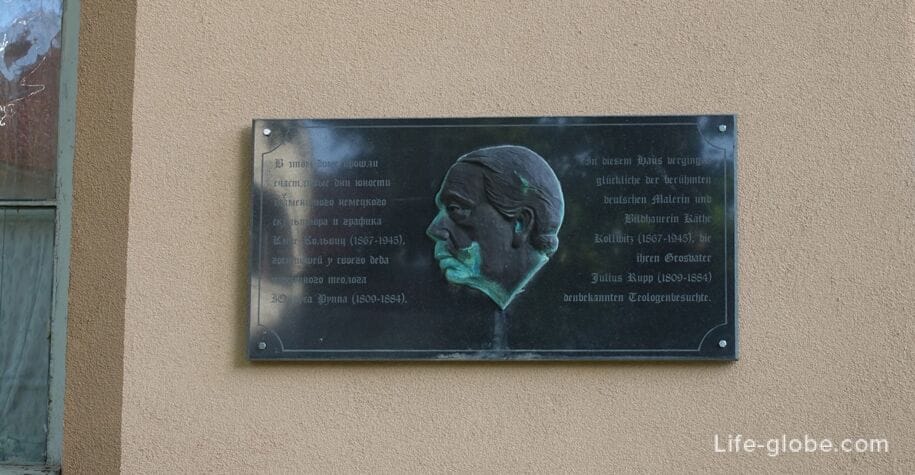
The Baptist chapel was erected in Rauschen in 1905 by Karl Glauss, who was its rector until 1942.
In the post-war years, the school sports hall was located in the building.
Since 2007, the building of the former Baptist Chapel houses the concert hall of the Children's Art School named after A.T. Grechaninov.
The chapel's address is 34 Kaliningradsky Prospekt.
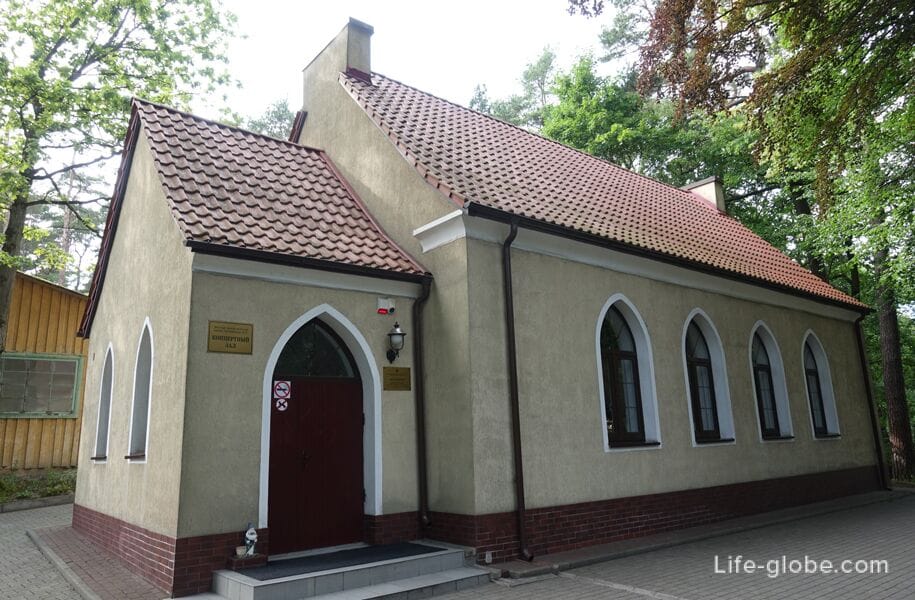
More than 50 soldiers who died in January-April 1945 are buried in a mass grave.
The monument was erected in 1950, the memorial complex of the work of architects V.P. Osipov and E.A. Popov was created in 1984.
The memorial complex is located at the address: Kaliningradsky Prospekt, 29, at the intersection with Zarechny Passage. GPS coordinates: 54°56'16" (54.937987) S.sh., 20°9'44" (20.162296) V.D.
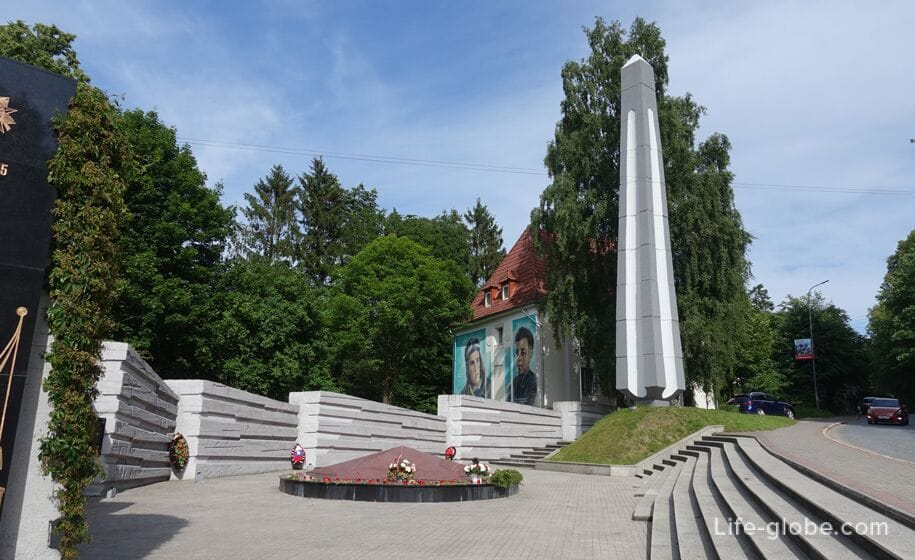
Near the memorial complex, on the opposite side of Kaliningrad Avenue, there is a sculpture "Woman with a wreath" mounted on a stepped pedestal.
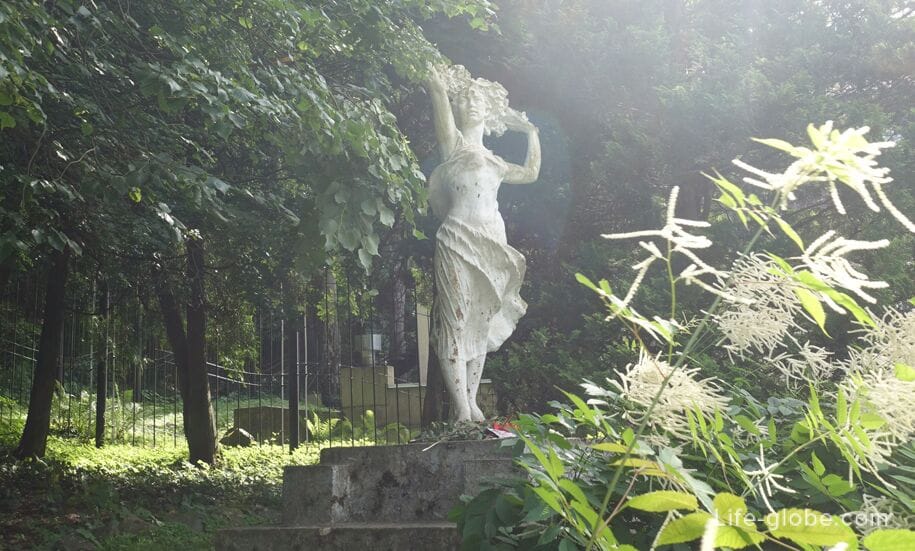
The historical building Villa "Zor" was erected, presumably, in 1904-1906 and was a two-story house with a basement, an attic and a spacious attic. Each floor was divided into apartments.
Until 2016, the building of the former villa was used as an apartment building, after which it was resettled and is currently being destroyed.
The address of the villa "Zor": Zarechny proezd, 5.
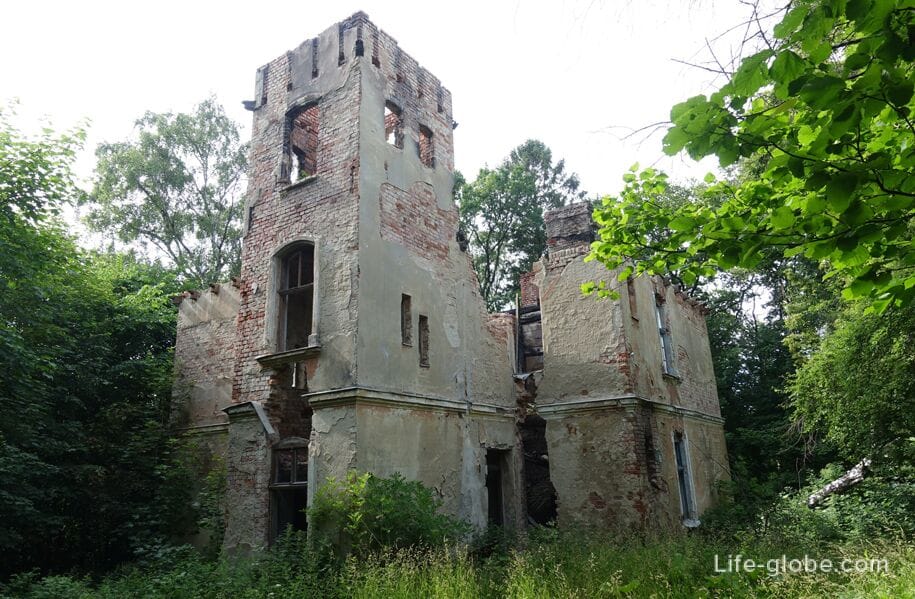
The guest house "Dune" (German name Hotel "Düne") was built in Rauschen in 1900, near a steep coastal slope overlooking the sea, on a small, now defunct street Westendstrasse (WestendStrasse) and was considered one of the most respectable hotels in Rauschen.
"Dune" was a three-storey Г-shaped building with a small basement and a sloping tiled roof, to which an open garden terrace with sea views and a park area adjoined. There was a steep staircase leading from the hotel to the sea, which still exists today, and facing the beach.
The owner of the hotel was Adolf Meslin, from whom in 1910 it was bought by the owner of the Kurhaus, Adolf Kaempf.
In the post-war period, the building housed the building of the Svetlogorsk military sanatorium.
Address: 1 Primorskaya Street.
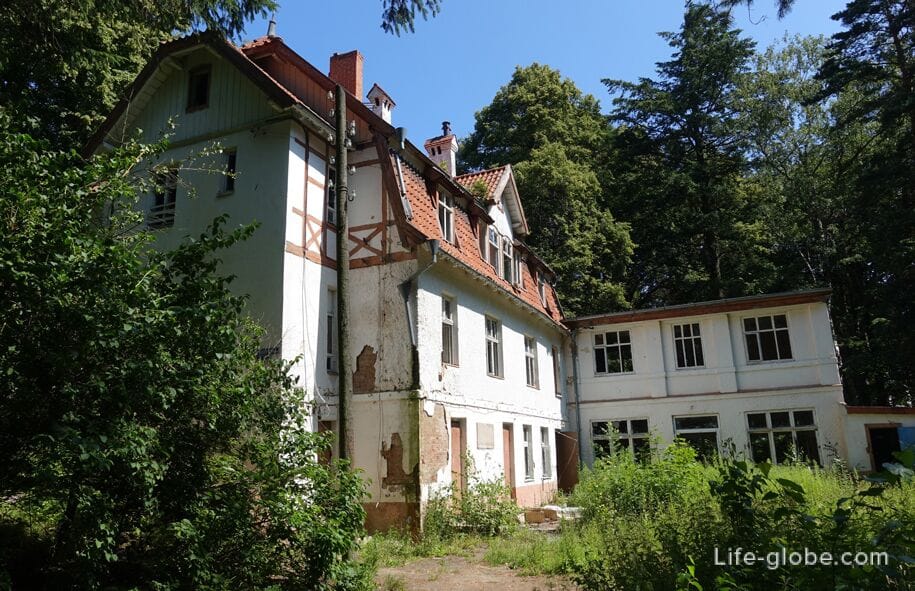
Villa "Rosenhof" was built in Rauschen around 1928 by architect Goering.
The villa is a two-storey building with two one-storey wings in the style of functionalism.
Now the building of the Svetlogorsk military sanatorium is located within the walls of the hotel.
Address: 11 Primorskaya Street.

Near the villas, along Moskovskaya Street, there are several more historical buildings, which are now the buildings of a military sanatorium.
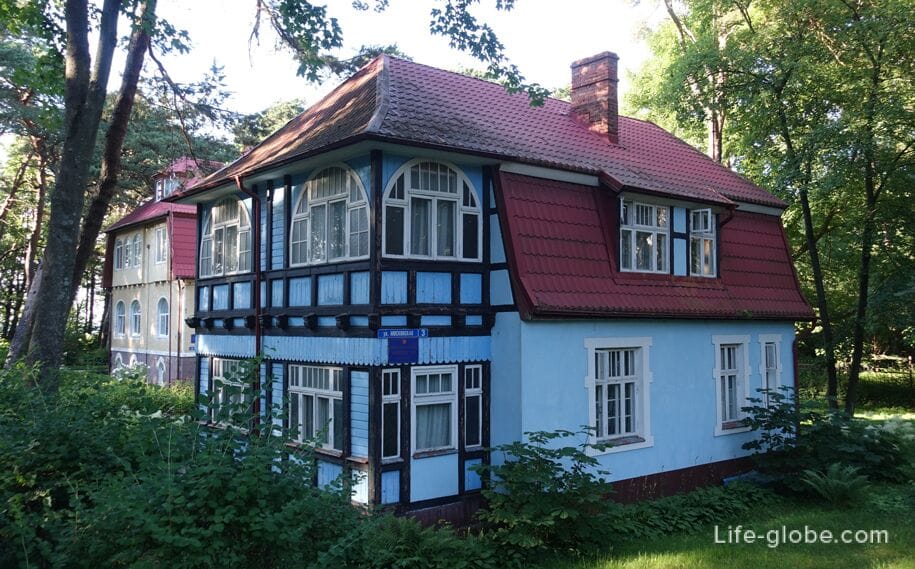
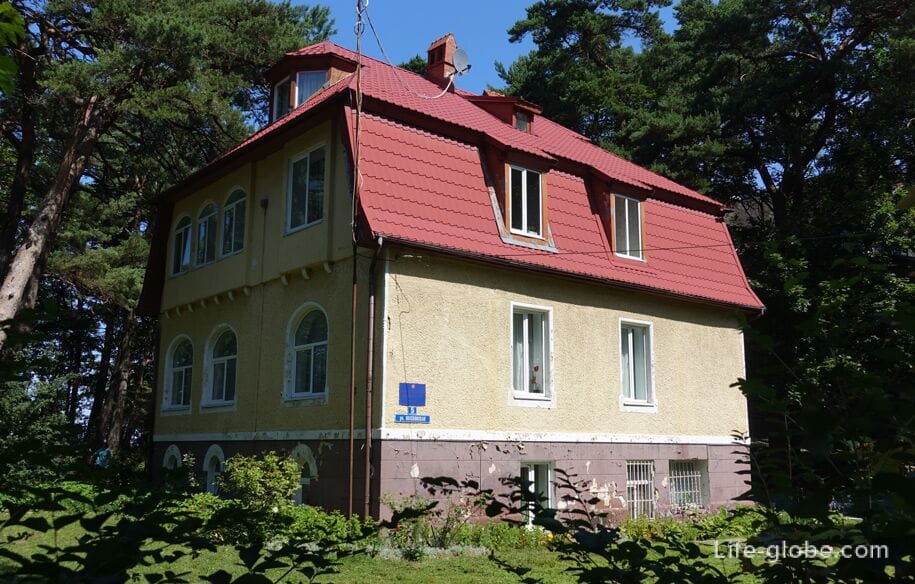

In addition to those listed, other sculptures and buildings of historical and architectural interest are also located in the center of Svetlogorsk, for example:
- sculptures of sphinxes decorating the entrance to the Leafy Park from Oktyabrskaya Street;
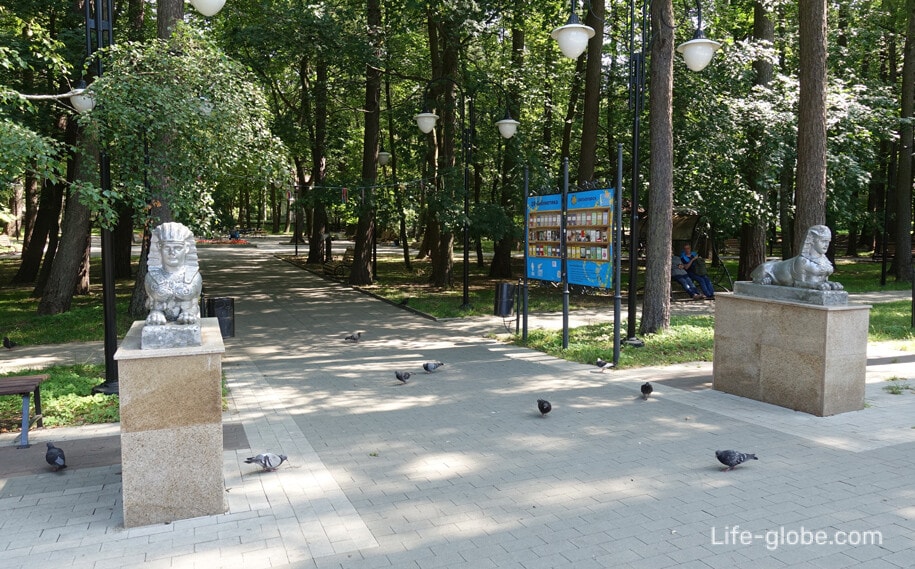
- sculpture "Children", located near the building of the Raushen hydrotherapy and representing a sculptural composition of children playing and vases;

- sculpture "Eagle", located on Oktyabrskaya Street near the Raushen Water Tower;
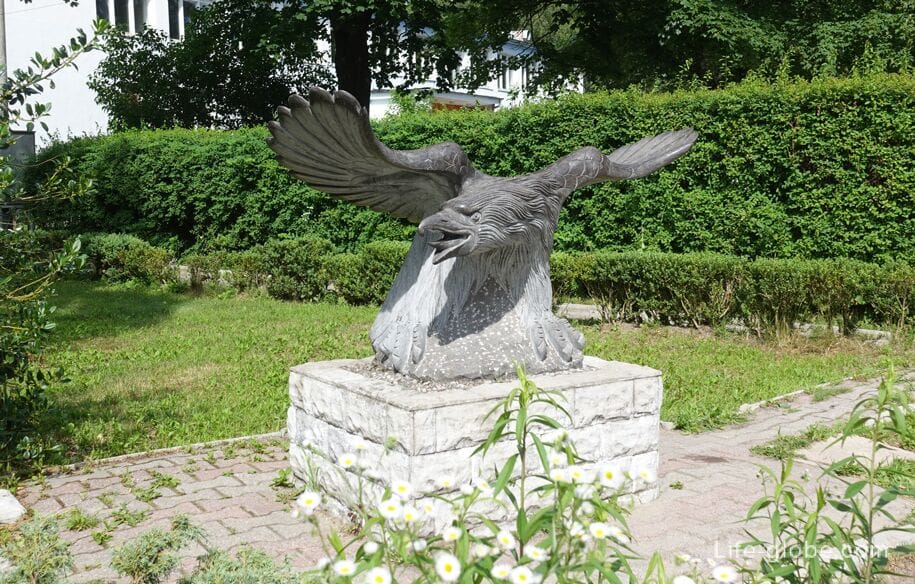
- sculpture "Duck", located at the intersection of Lenin and Karl Marx streets.
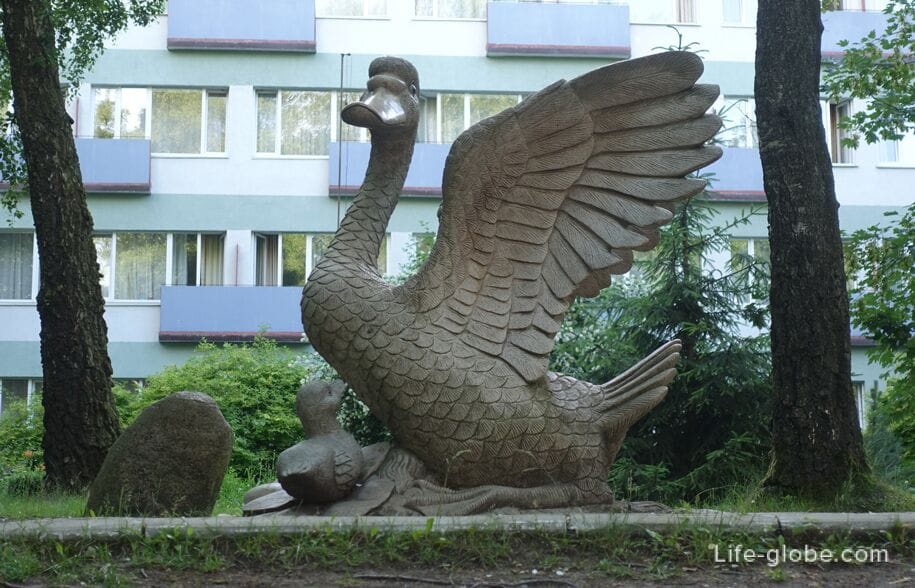
- a building with a tower built in Raushen in the pre-war years, which now houses the FLK branch of the Military Sanatorium of the Ministry of Defense of the Russian Federation and a flower shop. Address: Oktyabrskaya street, house 14;

- the house where Viktor Leonidovich Batrakov, the head of the Svetlogorsk Central Military Sanatorium, lived from 1975 to 1998. Address: Oktyabrskaya street, house 16;
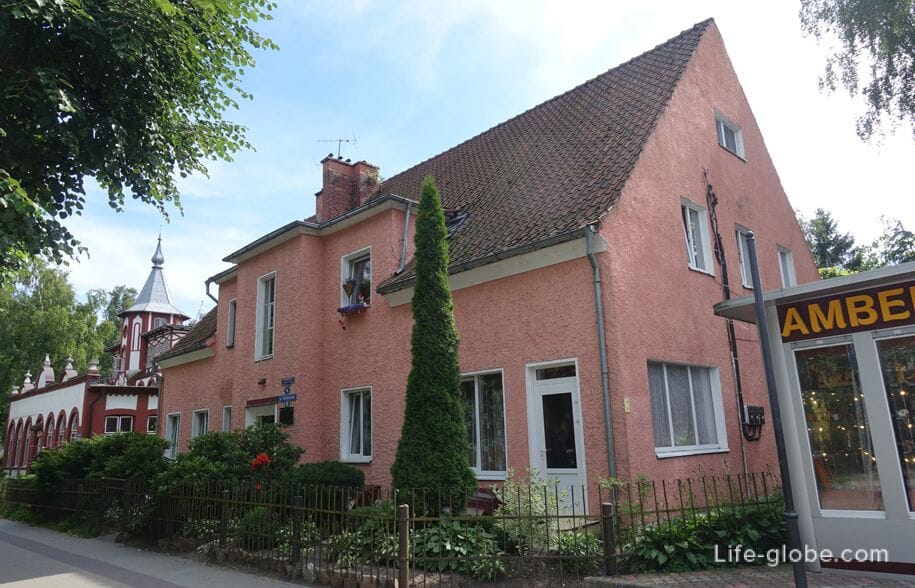
- other buildings.
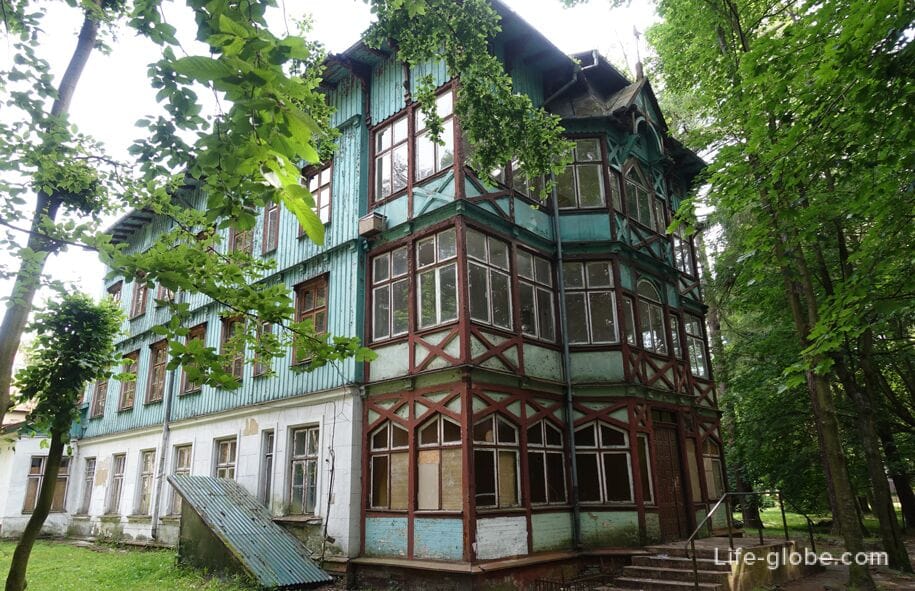
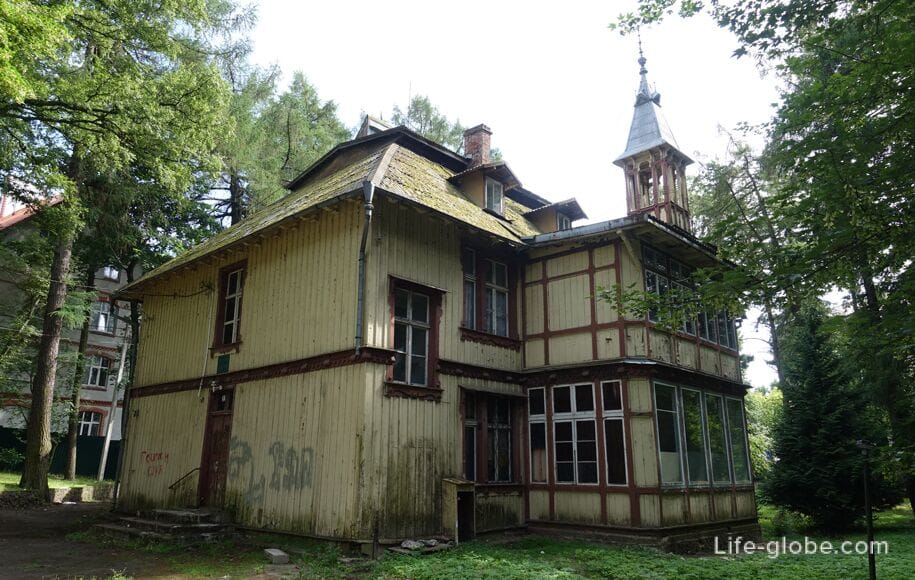
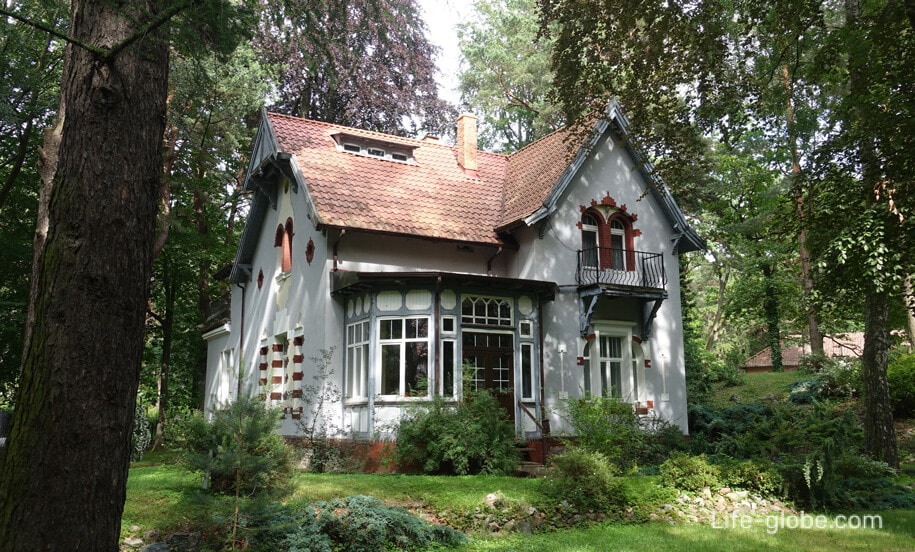
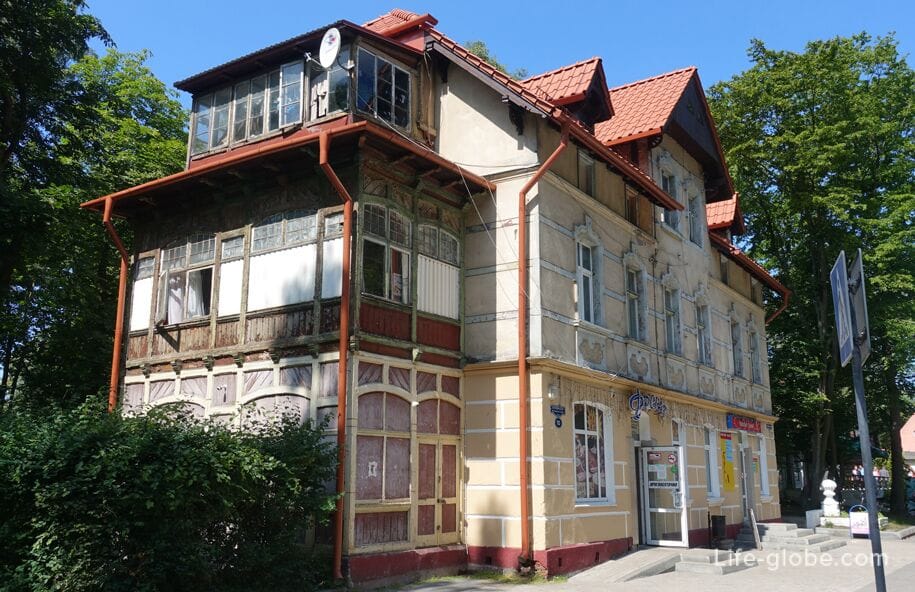
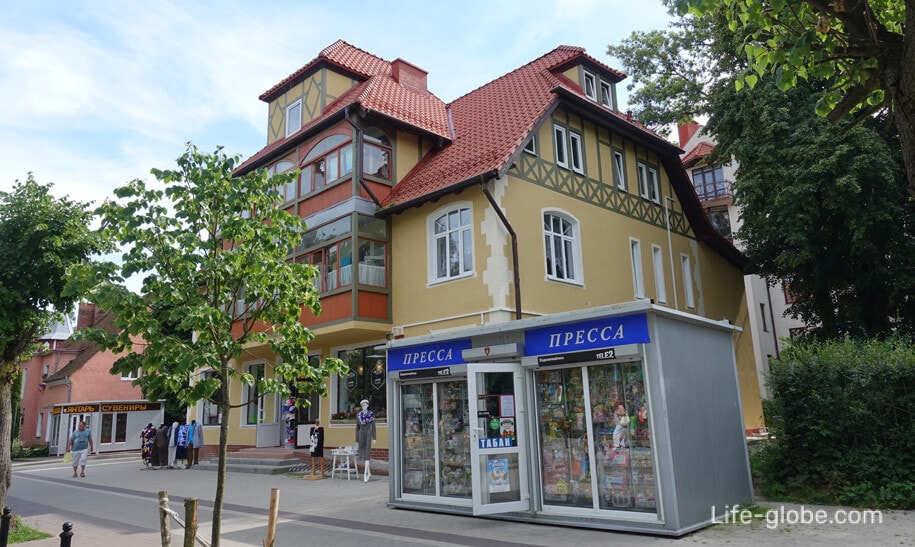
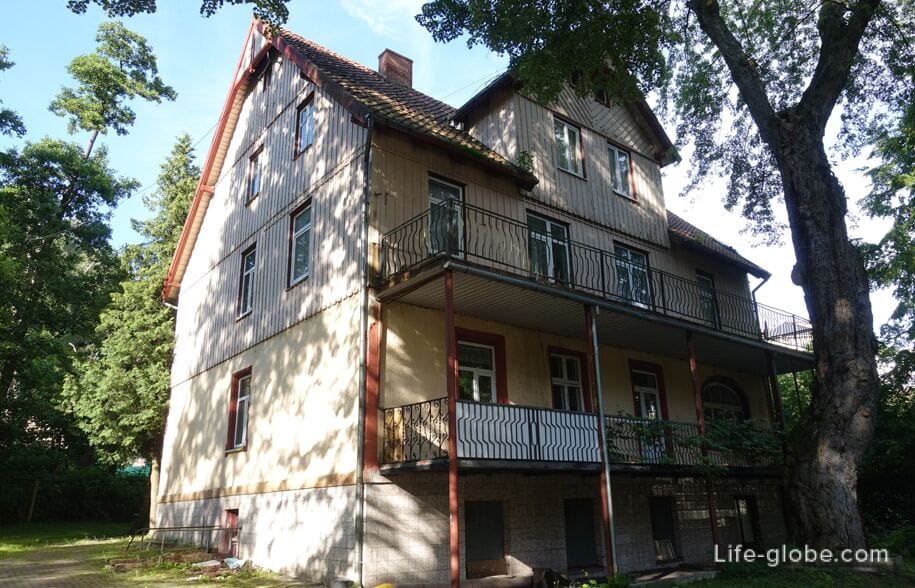
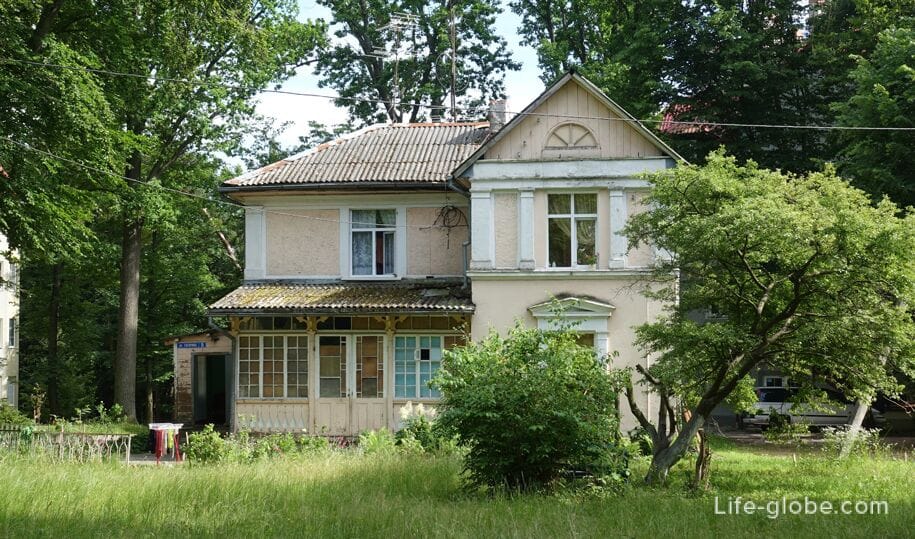



A separate group of attractions can include museums and exhibitions, both of Svetlogorsk itself and the village of Otradnoye, which is part of the Svetlogorsk urban settlement and located 2 kilometers from the center of Svetlogorsk. Learn more about the museums and exhibitions of Svetlogorsk and Otradnoye...

In addition to museums, there are some attractions in the village of Otradnoye: significant historical sites, a museum and a park with themed areas. Learn more about the sights in Otradnoye...
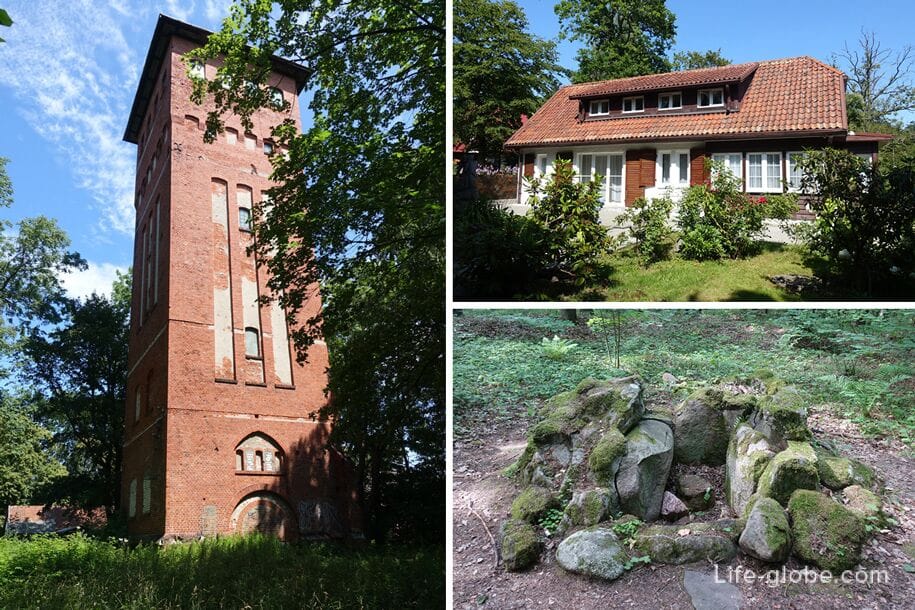
All accommodation facilities in Svetlogorsk (hotels, apartments, guest houses, etc.), including near beaches and the embankment, in the city center and more remotely from those, can be viewed and booked here